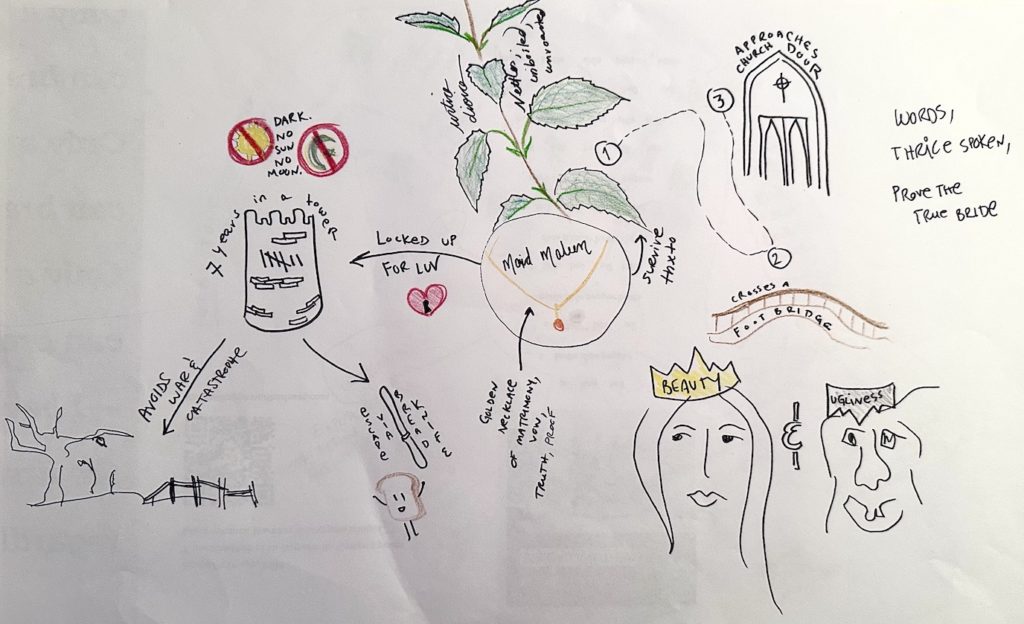
Meredith and I proceed with our Grimm’s Fairy Tale book club. She wrote a reflection that really got me pumped, at once a light, quick, touch, and yet it covered a lot of ground.
After reading this tale to myself, I read it aloud to my son. He and I were both surprised that the princess and her maid spent seven tormented years in a dark tower, with no light, but were able to emerge within days by picking away at mortar. Really? You couldn’t have done this seven years ago, and ran away with your betrothed? Ah, but then there would be no tale. The princess seemed to have agreed to her tyrannical father’s punishment. A punishment (or curse) is a punishment, and must be fulfilled if balance is to be restored. So, I’ll set aside my questions about what daddy King did or thought about on the first birthday after locking his child away, or the first Christmas celebration. You do your duty, you follow the rules, and that is that. But you can play with the rules, as the wedding ceremony at the end of the tale shows us.
Maid Maleen agrees to participate in the wedding ceremony as an imposter. She plays part in a big lie, and does as she is told–else she would have been put to death. But Maleen is clever, and says (sings) three enchanted little verses along the way to the church, mentioning her true name each time as well. These enchanted words become the proof of her identity. I keep going back to this theme, of proof. Seven years had passed since the prince was separated from his beloved, and he immediately thought “She is like my Maid Maleen” upon seeing his “bride”. Wouldn’t you say something right away?? Ah, but then there would be no tale. The prince plays along, and finds his own way to prove identity: demanding that his false bride reveal what was said along the way to the church, and the gift of the precious chain and jewel around the neck. The motif of mistaken or hidden identity is present in many of the Grimm’s Fairy Tales. So many of Shakespeare’s plays, and here’s a list of some classic operas with mistaken identity, disguises, and costumes. What is important about this? Were people really unable to recognize one another in centuries past, given that their exposure to photographic images or manufactured images whatsoever was limited? Or, is this about exposing multiple possible universes that may or may not exist at every moment, with character-as-shapeshifter, able to travel the multiverse?
Now, this is just an internet search, but it seems that
Maleen means “of Magdala” with Magdala meaning “tower” (from Hebrew “migdál/מִגְדָּל”)
Source
Aha! (Side note, in Polish, migdał is almond, a tree which has powerful positive symbolism, including that of some inner truth or true nature within a shell). Maleen was beautiful before, and after her confinement in the tower. Her outer beauty remained intact, despite seven years in darkness. Is her punishment in the tower a symbolic death, where she must go into the darkness (the Underworld, the Otherworld) and refine her base self into something with inner beauty, too? Seven years is a long time–this is no “three days and then he rose again” journey. Why seven long years? It is only when Maleen runs out of food and drink that she dares to escape the tower. Eating the food in the underworld keeps you there longer (remember Persephone). Had Maleen and her maid not eaten any of the food, would they still have been trapped in the tower? Continuing to eat food and nourish our bodies keeps us trapped in the physical, in the pleasure of Samsara? Pffff, going off on a limb here. A graceful almond-tree limb.
In this tale, unlike the previous one we read together, we have only plants play a role (nettle, perhaps almond), but not animals. Kings and princesses and marriage all around, though.
I love nettles, and drink the tea almost daily. I have then growing in my little garden plot, though I have yet to sing to them–perhaps I will, though they don’t need much encouragement, they grow strong.